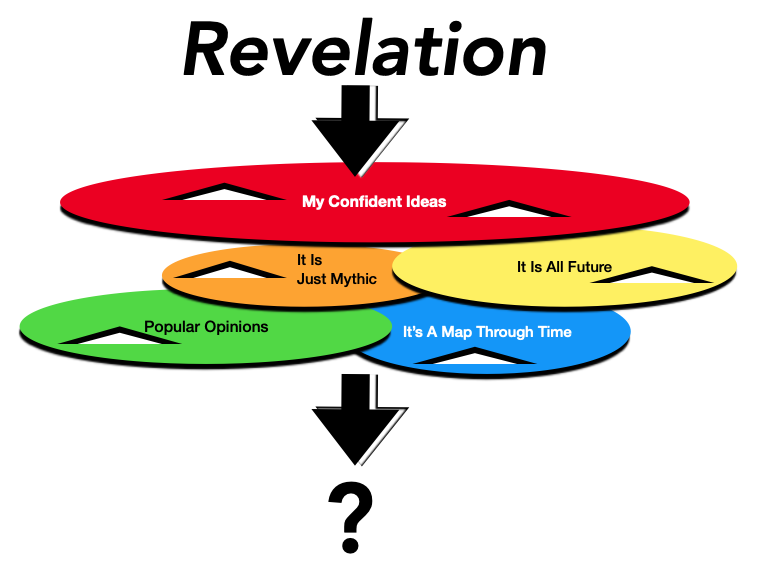From the sensational to the enigmatic, John’s Revelation has spawned a plethora of understandings. Yet many of these possess a commonality. Often the interpretation is the result of imposing upon the text a non-literary filter foreign to the text. Such filters might be one’s confident expectation that Revelation describes ___ or perhaps it consists of a grid that assumes a map metaphor outlining church history.
Filters will produce a message. But is the understood message what the author intended?
What if we were to allow the genre of Revelation to suggest how we interpret it? What if we took seriously its own words? Let me suggest where such an exploration would take us.
1) Revelation Involves A Prophecy Which Would Soon Take Place From When It Was Written.
Revelation 1:1, 3; 22:7, 10, 18 Repeatedly and very clearly, John tells us this is a prophecy which would be fulfilled soon.
But what about the idea that: "with the Lord, a day is a like a thousand years and a thousand years are like a day?" 2 Peter 3:8 While this is true, in the Revelation Jesus sought to convey an understandable message to the seven churches. As such, it needs to communicate in a frame of reference people understand, not God’s framework! This was written in human language for the human perspective, not’s God’s timeless perspective.
When John wrote the message, the events were already unfolding. In fact, five of the seven heads (kings) of the first beast had already died. Revelation 17:9-10
2) Revelation Is Written In A Style That Shares Many Methods And Characteristics Of Apocalyptic Literature.
Just as “once upon a time” is a literary key about the framework which should be used for interpreting a story, so too, by writing in a style that shares many characteristics of apocalyptic literature, John has provided us with a general starting perspective for interpretation. Some of the qualities of this style of writing include: symbolic imagery and use of numbers, borrowing images from known sources, visions, and a strong dualism between good and evil. A few of the symbols in Revelation which are explained can be found in 1:20; 5:8; 12:9.
3) Apocalyptic Works Were Written During Times Of Distress To Provide Encouragement.
Encouragement can be provided by a “behind the scenes” explanation of what is going on and where the current situation will lead. Already some from among the recipients of Revelation had died for the cause of Christ while others would still face persecution. Rev. 2:10; 2:13 The theme of Christ’s community being persecuted and how long this would continue dominates the book. Rev. 1:9; 6:10-11; 7:14; 13:15; 14:13; 17:6; 18:24; 19:2; 20:4 Encouragement is provided to the seven churches in knowing that God’s judgment would bring an end to the forces of persecution.
4) From Its Very Beginning, Revelation Reveals It Is Built Upon A Strong Familiarity Of Old Testament Language and Imagery.
Compare: Revelation 1:8,17 with Isaiah 44:6; Revelation 1:13-17 with Daniel 10:5-9, and so forth.
Noteworthy is how the Old Testament uses cosmic language to depict God’s judgment on political powers: Against Egypt “the Lord rides on a cloud and is coming to Egypt” (Is. 19:1); against Babylon God’s judgment was described as “the day of the Lord is coming” when “the rising sun will be darkened” (Is. 13:7, 10), against Edom the sky rolled up like a scroll (Is. 34:4,5); and when against Samaria the people said to say to the mountains, ‘Cover us.’” (Hos. 10:8). Furthermore, although specific nations were being judged, the completeness and thoroughness of God’s judgment was described through the superlative language of being upon the whole world. Is. 13:11; 34:2
When John employs such familiar and biblical cosmic language depicting how God overthrew political powers in the past, this suggests how we might want to approach such cosmic judgment language in Revelation. The catastrophic language in Revelation parallels what we find in the Old Testament for the fall of nations. Therefore statements about Jesus’ coming (Rev. 1:7; 3:11, 22:7, 12, 20) as well as the message of Revelation 6:12-17 could refer to a future divine judgment, at least from the writer’s timeframe, against a political nation and its downfall. Accordingly, such cosmic imagery of upheaval does not necessarily demand that we understand it describes the end of the world.
Next week we’ll explore some remaining keys for a literary sensitive interpretation.
- Christian Virtues Impact - 2025-12-17
- Works Vs. Doing - 2025-12-08
- The Bonfire - 2025-12-03
